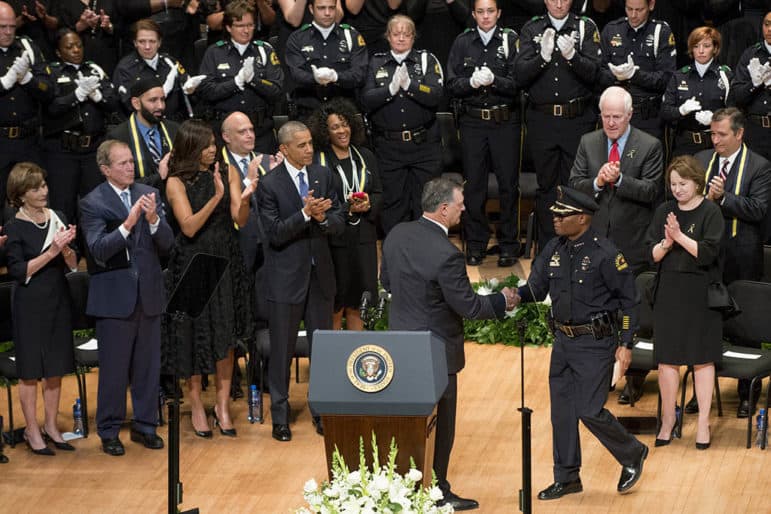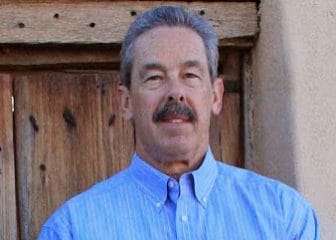
Robert Hart / The Texas Tribune
Dallas Mayor Mike Rawlings shakes Chief of Police David Brown’s hand as former President Bush, President Obama, their wives, U.S. Sens. Cornyn and Cruz and others applaud at a recent memorial for five police officers killed in Dallas.
COMMENTARY: I’d have to go back 50 years to remember a time when this country was embroiled in racial strife to the degree which it is today. Recently five Dallas area police officers were murdered, and seven more wounded, because of their skin color and the fact that they wore that uniform. Ambush-style shootings in other states occurred the following day.
I have watched video of men shot by individual police officers, reportedly because of their ethnicity, and if that was not the actual reason for the shootings it certainly seems to many black citizens of this country that they are being targeted. There is outrage, anger, frustration, and fear among persons of color.

Courtesy photo
J.R. Lonsway
Oddly enough, both police and persons of color feel that they are being unfairly targeted. Police officers see themselves as being blamed for any shooting that occurs anywhere in the country, and regardless of locale, are held accountable for the actions of law enforcement officers from other agencies and states.
People of color see themselves as potential victims of a law enforcement system they perceive as having little oversight, with an entrenched mentality that being black equals criminal wrongdoing.
It’s time for a change.
We need to rethink the way we do business in our communities. Instead of relying on politicians at the national level to provide leadership to remedy the race problems we have in this country, do it at the local level. The city fathers, police department administrators, NAACP, college and university black student unions, and other organizations representing people of color should interact on a regular basis.
Sure, it’s great to get together once a year for breakfast on Martin Luther King Jr.’s birthday, but on what other occasions do they meet? Make the time to open up the lines of communication, voice concerns, build trust and understanding, and when the next incident happens involving the police and a person of color it won’t have to be confrontational.
It’s not going to happen with one meeting, it won’t happen with five meetings, but it can happen. When people know each other on a first-name basis, it makes dealing with a crisis much easier.
The media needs to police itself. We have two types of journalism in this country: liberal and conservative, and the bias in reporting is obvious. Whether news outlets want to admit it or not, sensational reporting that ignores facts is fanning the flames of fear, anger, bigotry, and hatred that lead to the looting, rioting, burning down of cities, and retaliatory violence against the police. Factual reporting has taken a back seat to being the first to report, and exploiting the situation for all it’s emotional worth.
Bear in mind, dear media, that not every police shooting that occurs is unjustified, and to play it up that way is an injustice to the men and women who serve. We have this little jewel in our Constitution called due process. Due process applies not just to citizens, but to police officers as well.
For those shootings that are not justified, remember that it takes time to investigate and bring rogue cops to justice, but it does happen. (For those who read that and say baloney, there have been plenty of shootings where cops were not brought to justice, remember that the criminal justice system is not designed to give each of us what we want at a personal level. And, when you disagree with a verdict or decision, before you whine ask yourself how much you actually know about the facts of the case. The facts in the case are not necessarily what you watched on TV).
Believe me as you read this, that police officers are just as horrified, outraged, and upset over unjustified acts of violence against citizens as anyone else.
There has been a political response at the national level for a standardized police use-of-force model. While there is no universal standard, I think most agencies are in the same ballpark when it comes to training officers by utilizing some form of a use-of-force continuum, and that might be a step in the right direction, especially bearing in mind Graham v. Connor.
Racism is not going to go away any time soon in this country, and neither is stereotyping. Police departments do their best to weed out individuals who think that way. While there are certain organizations out there that believe cops are inherently racist and out to do harm to black people, that belief, in and of itself, is nothing more than blatant racism, and I disagree with the mindset. To paint a profession with one broad stroke as being traditionally against persons of color is as weak an argument as saying that all persons of color are criminals.
I remember after September 11, 2001, how the citizens of this country loved their cops. They recognized the courage and sacrifice made by men and women in blue, and the outpouring of appreciation for the job they performed was welcomed. It would be nice to get back to that, but it’s not going to happen without communication and trust on both sides.
J.R. Lonsway is a retired deputy chief of police with the City of Las Cruces and the author of Twenty. He blogs at jrlonsway.com.